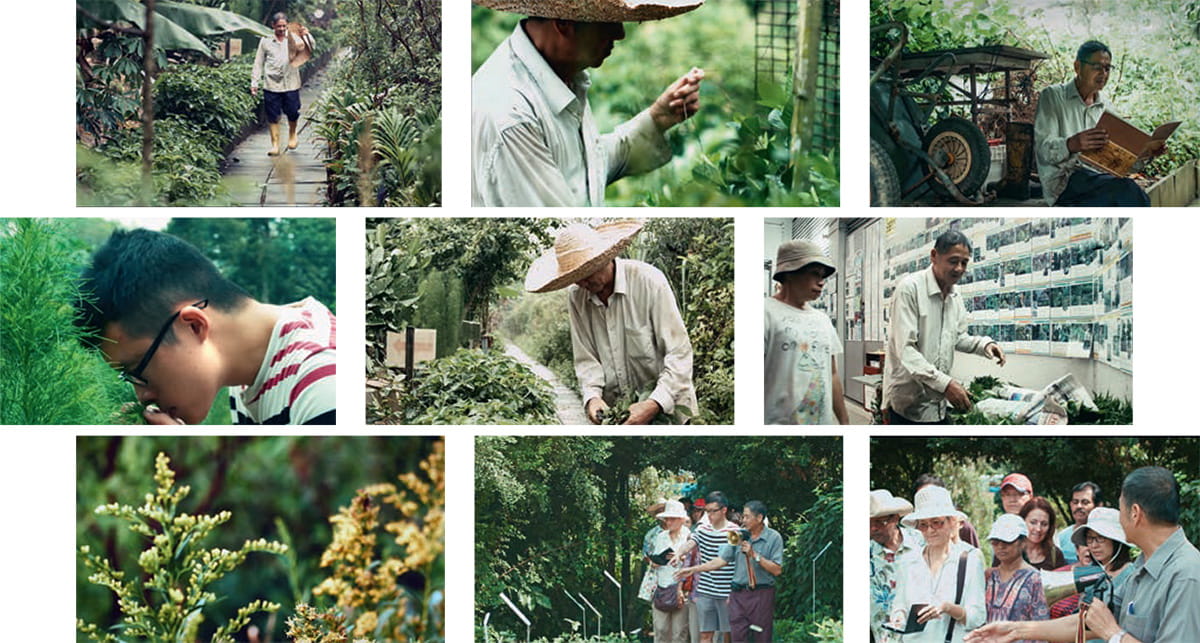Stories > A Garden Dispensary
A Garden Dispensary
Ng Kim Chuan spends his time quietly tending a herb garden and giving away its produce to visitors for free. We find out why.
BY WONG SHER MAINE

ucked away beside Nanyang Technological University (NTU)’s Jalan Bahar entrance is a garden the size of two soccer fields. Cultivated for eight years now, it contains nearly 300 plant varieties, from fruit trees to a staggering array of herbs.
Here, the ingredients that make up traditional home remedies are grown, gathered, and dispensed. These herbs are distributed free of charge to a steady stream of visitors, most of whom hear about the garden through word of mouth.
Head gardener Ng Kim Chuan, 65, who started the garden, and his team gained their herbal knowledge from older family members, or through reading books. He rattles off the names and specific healing properties of the plants under his care with ease. “If you boil this saw-toothed coriander leaf, the water can sooth itchy skin,” he says.
A GREEN CALLING
Ng grew up in the farming community, first in Jurong then in the Lim Chu Kang area where he tended vegetables and chickens. Farming took a back seat when he started working at NTU as a maintenance worker. But when his younger brother developed lymphoma, he started thinking of growing things – specifically, healing foods – again.
Ng, who works as a research assistant at the NTU School of Biological Sciences today, started the garden in 2009. He began reading up about herbs and their healing properties. Today, NTU, which owns and manages the garden, also offers the plants to National University of Singapore, Singapore Polytechnic, and other tertiary institutions for research purposes.
Since the garden opened to the public, more people have been finding out about it via social media. Some days, over 100 people pour in. To date, harvested herbs have been given to over 6,000 visitors seeking natural remedies. Visitors call to make appointments at the garden, which is open on Mondays, Wednesdays, and Fridays.
When the visitors turn up, Ng walks around with a pair of shears, clipping bits and pieces of relevant plants for them. He carefully records what the regulars have taken; it helps him keep track of their health. These records now fill several books.
That the herbs are free is a blessing for the many visitors from lower-income households; a considerable number are afflicted with cancer.
Volunteer Zhuang Min Shan, a registered traditional Chinese medicine physician, says: “The garden gives them hope. Some of the patients who come here have no means to afford mainstream cancer treatment, and would have otherwise given up.”
Those who seek the herbs also include people from China, Canada, Malaysia, Indonesia, and the Philippines.
“They have herbs in China, of course, but some Asian herbs cannot be grown there,” explains Ng. The garden has received visitors from organisations as far away as Beijing University of Chinese Medicine. Their photographs are plastered all over the awning that forms a makeshift office.
“The garden gives them hope. Some of the patients who come here have no means to afford mainstream cancer treatment, and would have otherwise given up.”
Zhuang Min Shan, volunteer, NTU Community Herb Garden
Indonesian Stephany Olivia, 26, was a newly matriculated student at NTU when she became fascinated by the garden. She has been honing her gardening techniques since then, and has even learnt Mandarin to speak with Ng and the garden’s visitors. She helps the gardener maintain a social media presence, including a Facebook page; its number of likes has jumped from 16 to nearly 3,000. She says: “I was not only amazed at the biodiversity in the garden, but was also touched and inspired to see so many people getting herbs for their health. I have also brought my family here, and suggested that my aunt take some herbs when she fell ill.”
HOPE FOR THE FUTURE
The NTU Community Herb Garden is maintained on a tight budget. Most of the stone tiles that comprise the garden path are salvaged discards, as are the wooden poles being collected for a work-in-progress sheltered walkway. Everything in the garden is made by hand. Ng, his assistant Bay Swee Hong, and two workers care for the plants and are responsible for the upkeep of the premises daily. Volunteers come in mainly on weekends, and during special visitors’ tours.
But, while more people are streaming in, either for plants or just to look around, funding remains a concern. Ng is thankful that some corporate sponsors have helped to defray costs, and have supported the building of an outdoor classroom for school groups. Still, he hopes for more support.
Since the herb garden was featured in January 2017 on Our Better World, the Singapore International Foundation’s storytelling platform, the garden has received gifts from 59 donors – almost six times the monthly number they had, prior to the coverage – in that month alone.
“Ultimately, I just hope that the younger generation can learn more about these interesting herbs and folk remedies, which are not welldocumented,” Ng says.
